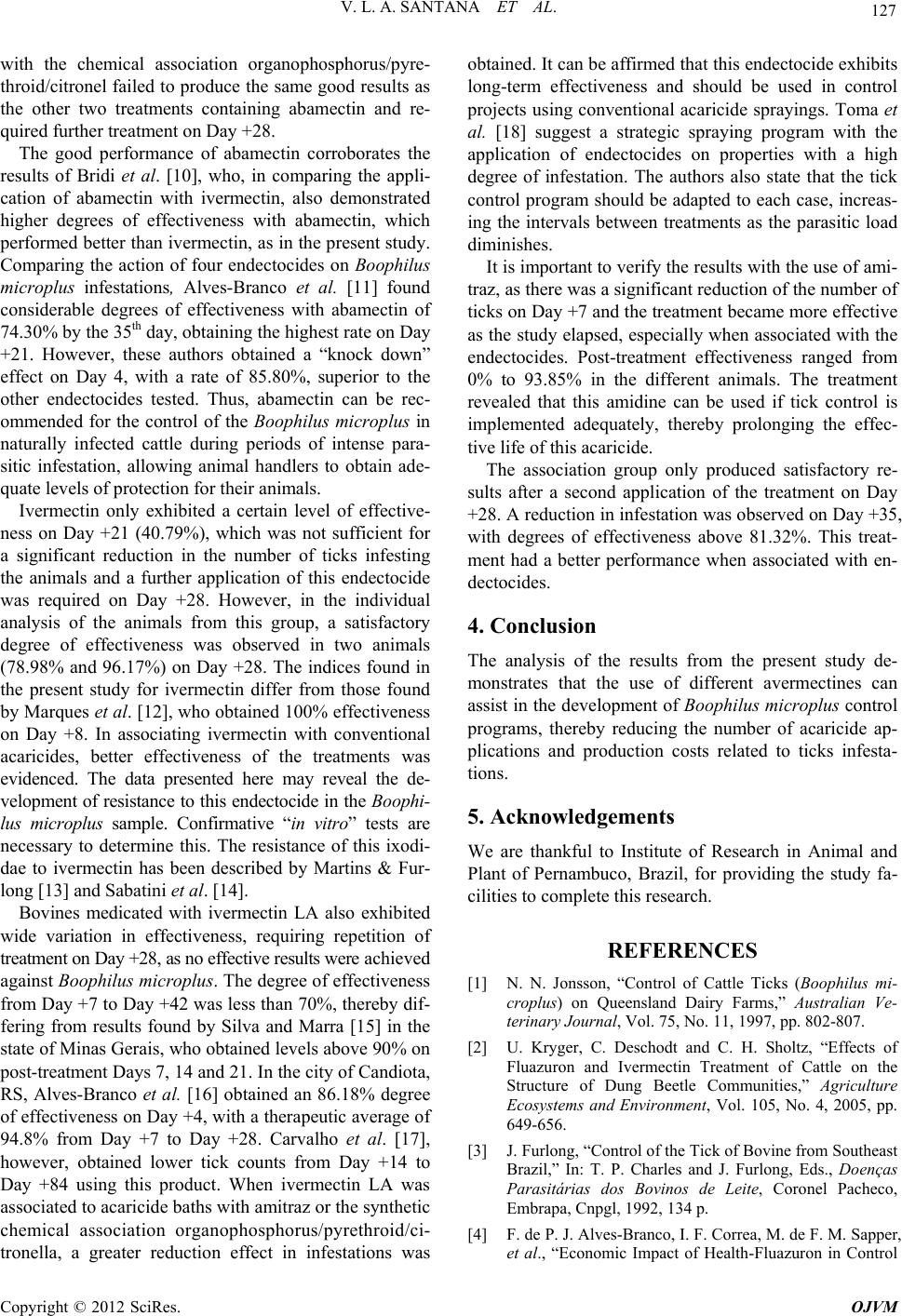
V. L. A. SANTANA ET AL. 127
withciatio anophus/pyr
throidproduce the goolts as
e ots contbamectin and re
also demonstrated
hi
s infesting
th
esults were achieved
ag
tronella, a greater reduction effect in infestations was
obtaIt can rmethistocidbits
long-term effectiveness anoulded irol
projectng contionalcidings. Toma et
is amidine can be used if tick control is
im
4.
d production costs related to ticks infesta-
REFERENCES
f Cattle Ticks (Boophilus mi-
tment of Cattle on the
Structure of Dung Beetle Communities,” Agriculture
Ecosystems an5, No. 4, 2005, pp.
649-656.
co,
the chemical asson orgosphore-
/citronel failed to
her two treatment
e sam
aining a
d resu
th -
quired further treatment on Day +28.
The good performance of abamectin corroborates the
results of Bridi et al. [10], who, in comparing the appli-
cation of abamectin with ivermectin,
gher degrees of effectiveness with abamectin, which
performed better than ivermectin, as in the present study.
Comparing the action of four endectocides on Boophilus
microplus infestations, Alves-Branco et al. [11] found
considerable degrees of effectiveness with abamectin of
74.30% by the 35th day, obtaining the highest rate on Day
+21. However, these authors obtained a “knock down”
effect on Day 4, with a rate of 85.80%, superior to the
other endectocides tested. Thus, abamectin can be rec-
ommended for the control of the Boophilus microplus in
naturally infected cattle during periods of intense para-
sitic infestation, allowing animal handlers to obtain ade-
quate levels of protection for their animals.
Ivermectin only exhibited a certain level of effective-
ness on Day +21 (40.79%), which was not sufficient for
a significant reduction in the number of tick
e animals and a further application of this endectocide
was required on Day +28. However, in the individual
analysis of the animals from this group, a satisfactory
degree of effectiveness was observed in two animals
(78.98% and 96.17%) on Day +28. The indices found in
the present study for ivermectin differ from those found
by Marques et al. [12], who obtained 100% effectiveness
on Day +8. In associating ivermectin with conventional
acaricides, better effectiveness of the treatments was
evidenced. The data presented here may reveal the de-
velopment of resistance to this endectocide in the Boophi-
lus microplus sample. Confirmative “in vitro” tests are
necessary to determine this. The resistance of this ixodi-
dae to ivermectin has been described by Martins & Fur-
long [13] and Sabatini et al. [14].
Bovines medicated with ivermectin LA also exhibited
wide variation in effectiveness, requiring repetition of
treatment on Day +28, as no effective r
ainst Boophilus microplus. The degree of effectiveness
from Day +7 to Day +42 was less than 70%, thereby dif-
fering from results found by Silva and Marra [15] in the
state of Minas Gerais, who obtained levels above 90% on
post-treatment Days 7, 14 and 21. In the city of Candiota,
RS, Alves-Branco et al. [16] obtained an 86.18% degree
of effectiveness on Day +4, with a therapeutic average of
94.8% from Day +7 to Day +28. Carvalho et al. [17],
however, obtained lower tick counts from Day +14 to
Day +84 using this product. When ivermectin LA was
associated to acaricide baths with amitraz or the synthetic
chemical association organophosphorus/pyrethroid/ci-
al. [18] suggest a strategic spraying program with the
application of endectocides on properties with a high
degree of infestation. The authors also state that the tick
control program should be adapted to each case, increas-
Emb
ined. be affid that endece exhi
d sh
acari
be us
e spray
n cont
s usiven
ing the intervals between treatments as the parasitic load
diminishes.
It is important to verify the results with the use of ami-
traz, as there was a significant reduction of the number of
ticks on Day +7 and the treatment became more effective
as the study elapsed, especially when associated with the
endectocides. Post-treatment effectiveness ranged from
0% to 93.85% in the different animals. The treatment
revealed that th
plemented adequately, thereby prolonging the effec-
tive life of this acaricide.
The association group only produced satisfactory re-
sults after a second application of the treatment on Day
+28. A reduction in infestation was observed on Day +35,
with degrees of effectiveness above 81.32%. This treat-
ment had a better performance when associated with en-
dectocides.
Conclusion
The analysis of the results from the present study de-
monstrates that the use of different avermectines can
assist in the development of Boophilus microplus control
programs, thereby reducing the number of acaricide ap-
plications an
tions.
5. Acknowledgements
We are thankful to Institute of Research in Animal and
Plant of Pernambuco, Brazil, for providing the study fa-
cilities to complete this research.
[1] N. N. Jonsson, “Control o
croplus) on Queensland Dairy Farms,” Australian Ve-
terinary Journal, Vol. 75, No. 11, 1997, pp. 802-807.
[2] U. Kryger, C. Deschodt and C. H. Sholtz, “Effects of
Fluazuron and Ivermectin Trea
d Environment, Vol. 10
[3] J. Furlong, “Control of the Tick of Bovine from Southeast
Brazil,” In: T. P. Charles and J. Furlong, Eds., Doenças
Parasitárias dos Bovinos de Leite, Coronel Pache
rapa, Cnpgl, 1992, 134 p.
[4] F. de P. J. Alves-Branco, I. F. Correa, M. de F. M. Sapper,
et al., “Economic Impact of Health-Fluazuron in Control
Copyright © 2012 SciRes. OJVM